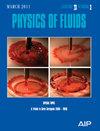双侧胸内动脉 Y 型移植物的竞争性血流:从血液动力学和过境时间血流测量参数中获得的启示
IF 4.1
2区 工程技术
Q1 MECHANICS
引用次数: 0
摘要
最近的研究表明,与其他移植方法相比,双侧胸内动脉(BITA)移植在治疗冠状动脉疾病方面具有更优越的疗效。竞争性血流(CF)是导致长期移植失败的主要因素。我们首次对 BITA-Y 移植物的竞争流进行了严格的数值分析。通过应用过境时间血流测量(TTFM)和血流动力学参数,这项研究为了解移植物的性能提供了一个新的视角。模拟结果表明,当血管狭窄程度低于 90% 时,平均血流量、TTFM 和血液动力学参数都在临界范围内。具体来说,当狭窄程度为 80% 时,左胸内动脉(LITA)的平均移植物流量(MGF)和搏动指数(PI)分别为 0.071 cc/s 和 27,而右胸内动脉(RITA)的平均移植物流量(MGF)和搏动指数(PI)分别为 0.211 cc/s 和 11。随着狭窄严重程度的增加,TTFM 参数保持在临床允许范围内(MGF > 0.34 cc/s,PI <5)。在狭窄严重程度达到 95% 时,LITA 的 MGF 和 PI 分别为 0.526 cc/s 和 1.2,而 RITA 为 0.790 cc/s 和 0.9。结果表明,当狭窄程度低于 90% 面积缩小率时,BITA-Y 移植体内存在竞争性血流,这表明移植存在长期失效的潜在风险。此外,研究结果表明,当两条原生动脉的狭窄严重程度存在显著差异时,BITA-Y 移植因 CF 而不是最佳选择,其特点是低 MGF 和高反向流。本文章由计算机程序翻译,如有差异,请以英文原文为准。
Competitive flow of bilateral internal thoracic artery Y-graft: Insights from hemodynamics and transit time flow measurement parameters
Recent studies have demonstrated the superior efficacy of bilateral internal thoracic artery (BITA) grafts compared to other graft methods in treating coronary artery disease. Competitive flow (CF) is a primary factor contributing to graft failure in the long term. For the first time, the CF of the BITA-Y graft has undergone rigorous numerical analysis. Through the application of transit time flow measurement (TTFM) and hemodynamic parameters, this study provides a new perspective on graft performance. Simulation results indicate that average flow, TTFM, and hemodynamic parameters fall within the critical range for stenosis severities below 90%. Specifically, at 80% stenosis, the mean graft flow (MGF) and pulsatility index (PI) of the left internal thoracic artery (LITA) were 0.071 cc/s and 27, respectively, while those of the right internal thoracic artery (RITA) were 0.211 cc/s and 11. With increasing stenosis severity, TTFM parameters remained within the clinical permissible limit (MGF > 0.34 cc/s and PI < 5). At 95% stenosis severity, the MGF and PI for LITA were 0.526 cc/s and 1.2, respectively, while those for RITA were 0.790 cc/s and 0.9. The results indicate the presence of competitive flow within the BITA-Y graft for stenosis severities below 90% area reduction, suggesting a potential risk of graft failure in the long term. Additionally, the results indicated that when there are significant differences in stenosis severity between the two native arteries, the BITA-Y graft is not optimal due to CF, characterized by low MGF and high reverse flow.
求助全文
通过发布文献求助,成功后即可免费获取论文全文。
去求助
来源期刊

Physics of Fluids
物理-力学
CiteScore
6.50
自引率
41.30%
发文量
2063
审稿时长
2.6 months
期刊介绍:
Physics of Fluids (PoF) is a preeminent journal devoted to publishing original theoretical, computational, and experimental contributions to the understanding of the dynamics of gases, liquids, and complex or multiphase fluids. Topics published in PoF are diverse and reflect the most important subjects in fluid dynamics, including, but not limited to:
-Acoustics
-Aerospace and aeronautical flow
-Astrophysical flow
-Biofluid mechanics
-Cavitation and cavitating flows
-Combustion flows
-Complex fluids
-Compressible flow
-Computational fluid dynamics
-Contact lines
-Continuum mechanics
-Convection
-Cryogenic flow
-Droplets
-Electrical and magnetic effects in fluid flow
-Foam, bubble, and film mechanics
-Flow control
-Flow instability and transition
-Flow orientation and anisotropy
-Flows with other transport phenomena
-Flows with complex boundary conditions
-Flow visualization
-Fluid mechanics
-Fluid physical properties
-Fluid–structure interactions
-Free surface flows
-Geophysical flow
-Interfacial flow
-Knudsen flow
-Laminar flow
-Liquid crystals
-Mathematics of fluids
-Micro- and nanofluid mechanics
-Mixing
-Molecular theory
-Nanofluidics
-Particulate, multiphase, and granular flow
-Processing flows
-Relativistic fluid mechanics
-Rotating flows
-Shock wave phenomena
-Soft matter
-Stratified flows
-Supercritical fluids
-Superfluidity
-Thermodynamics of flow systems
-Transonic flow
-Turbulent flow
-Viscous and non-Newtonian flow
-Viscoelasticity
-Vortex dynamics
-Waves
 求助内容:
求助内容: 应助结果提醒方式:
应助结果提醒方式:


